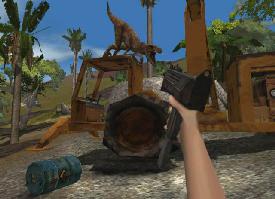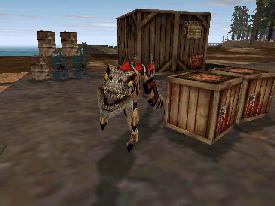So pretty, sooo slow.
As we make that final turn into the holiday season, there’s a horde of new
engines running at us at full speed. Some are brand spankin’ new, while some
are licensed or hybrids of licensed engines. The famed Half-Life, for
example, uses some bits and pieces of Quake and Quake
II. Others, like Requiem and Thief, are showing off new technology.
Just how does Dreamworks’ Trespasser stack up to the competition? Well, I’ve got two simple words to describe the game’s graphical engine: gorgeous and slow. On the other hand, the game’s sound and physics are the best yet, provided you have the system to support them. Technology aside, however, Trespasser‘s gameplay fails to live up to expectations and players are in for a very basic puzzle-solving, dino-killing experience.
The premise of the game is based on Michael Crichton’s two Jurassic Park novels (and later movies). For those who’ve been living in a cave, here’s a little refresher course. Dinosaur blood found, dinosaurs cloned for human amusement, park built on island to house dinos, dinos refuse to be housed, and finally, dinosaurs kill people. Then there’s a little twist in the sequel – the actual cloning part is done on a secret island called Site B and the dinos were shipped over to the major island. The story begins as you, compliments of Minnie Driver’s voice, crash land on this long-deserted Site B while vacationing in Costa Rica. From there on you’ve got the usual FPS (first-person shooter) deal: find guns, avoid/kill bad things (in this case, dinosaurs) and try to find safety. However, Trespasser does have many advantages over previous blast-everything-in-sight type games we’ve seen so much of.
The first and most obvious advancement Trespasser lends to the FPS genre is its sweet-looking engine, the most impressive aspect of which is the gorgeous terrain/landscape. It has the furthest rendering distance of any first-person engine thus far; players have the ability to explore huge, somewhat non-linear levels without the interruption of a loading screen and gaze for what seems like miles across a canyon or landscape. In addition, all 7 species of dinosaurs have an exceptionally high polygon-count and realistically fluid movement. Several other goodies also show their face throughout the game: the water physics top those found in Unreal, the particle system is realistic, real-time shadows are impressive, etc.
Unfortunately, there are a few flaws. While the game’s mip mapping system looks and works great for objects a great distance away, there are obvious jumps from mip map to texture map at close range. This results in the constant warping of objects (tress, rocks, boxes, etc.) from low to high detail when walking around. The engine’s greatest flaw is not in its mip mapping system, but its speed. On anything less than a top of the line system it’s just not worth it. Unless you’ve got a 333 to 400 MHz PII with serious acceleration like a Voodoo II or TNT (AGP) , be prepared for a lot of chunk and low-resolutions. Even with a Voodoo II-powered 400 MHz PII, I found a lot of slowdown, especially when more than one dinosaur was in the scene. While many engine bugs were fixed in the recently released patch, the speed difference is minimal.

The thing that sets Trespasser apart from its FPS rivals is its sound and physics engine. Everything in the game is a movable object: guns, boxes, rocks, car doors and even dead dinosaurs can be grabbed, picked up and thrown. As in real life, the extent that you can throw an object is based on its weight. Guns, small boxes and tiny rocks can be hurled some distance, while large boxes are impossible to throw and hard to drag around. Also, dropping boxes and other breakable things from a distance will shatter that object and reveal the game’s cool particle system. As a result of two objects colliding, the sound system will generate an impact noise based on their structure and velocity. Very cool stuff.
The game plays like any other first person shooter, with a few minor exceptions. Because everything is an object, guns must be manually picked up (the same process as picking up a rock, or box). From here you can move your arm and rotate your wrist. In the end, however, it is much easier to leave the arm straight and rotate the body as most of us FPS fans are used to.
Trespasser fails to break away from the tired, linear, basic gameplay that made the FPS genre so famous. Sure, the levels are somewhat open, but the overall goal of each level is to go from point A to point B with the usual key-finding, enemy-killing, button-pushing nausea along the way. There just isn’t much new ground broken.
Unfortunately, despite the advanced physics and gorgeous graphics engine, Trespasser falls far short of its expectations. Though the engine can look damn good, it will only be experienced by those with kick-ass systems…and even they’re in for some slow-down. The physics and sound engines are very admirable – if only the gameplay had been up to par. In the end, if you’ve got a really monster system (and I’m talking REALLY kick-ass), you might want to take a look. Anything less and, well, pass this one up…but don’t worry. Plenty of great looking games are on the way and should fit your fancy and system requirements.







